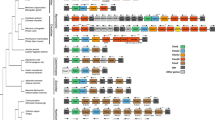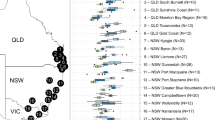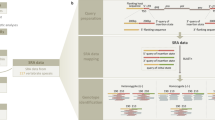Abstract
Human endogenous retroviruses (HERVs), which are remnants of past retroviral infections of the germline cells of our ancestors1, make up as much as 8% of the human genome and may even outnumber genes2,3. Most HERVs seem to have entered the genome between 10 and 50 million years ago, and they comprise over 200 distinct groups and subgroups1,4. Although repeated sequence elements such as HERVs have the potential to lead to chromosomal rearrangement through homologous recombination between distant loci, evidence for the generality of this process is lacking. To gain insight into the expansion of these elements in the genome during the course of primate evolution, we have identified 23 new members of the HERV-K (HML-2) group, which is thought to contain the most recently active members. Here we show, by phylogenetic and sequence analysis, that at least 16% of these elements have undergone apparent rearrangements that may have resulted in large-scale deletions, duplications and chromosome reshuffling during the evolution of the human genome.
This is a preview of subscription content, access via your institution
Access options
Subscribe to this journal
Receive 12 print issues and online access
$209.00 per year
only $17.42 per issue
Buy this article
- Purchase on Springer Link
- Instant access to full article PDF
Prices may be subject to local taxes which are calculated during checkout


Similar content being viewed by others
References
Boeke, J.D. & Stoye, J.P. in Retroviruses (eds Coffin, J.M., Hughes, S.H. & Varmus, H.) 343–436 (Cold Spring Harbor Laboratory Press, Plainview, NY, 1997).
Lander, E.S. et al. Initial sequencing and analysis of the human genome. Nature 409, 860–921 (2001).
Venter, J.C. et al. The sequence of the human genome. Science 291, 1304–1351 (2001).
Jurka, J. Repbase update: a database and an electronic journal of repetitive elements. Trends Genet. 16, 418–420 (2000).
Barbulescu, M. et al. Many human endogenous retrovirus K (HERV-K) proviruses are unique to humans. Curr. Biol. 9, 861–868 (1999).
Sugimoto, J. et al. Transcriptionally active herv-k genes: identification, isolation, and chromosomal mapping. Genomics 72, 137–144 (2001).
Ono, M. Molecular cloning and long terminal repeat sequences of human endogenous retrovirus genes related to types A and B retrovirus genes. J. Virol. 58, 937–944 (1986).
Blanco, P. et al. Divergent outcomes of intrachromosomal recombination on the human Y chromosome: male infertility and recurrent polymorphism. J. Med. Genet. 37, 752–758 (2000).
Rearden, A., Magnet, A., Kudo, S. & Fukuda, M. Glycophorin B and glycophorin E genes arose from the glycophorin A ancestral gene via two duplications during primate evolution. J. Biol. Chem. 268, 2260–2267 (1993).
Schwartz, A. et al. Reconstructing hominid Y evolution: X-homologous block, created by X–Y transposition, was disrupted by Yp inversion through LINE–LINE recombination. Hum. Mol. Genet. 7, 1–11 (1998).
Johnson, W.E. & Coffin, J.M. Constructing primate phylogenies from ancient retrovirus sequences. Proc. Natl Acad. Sci. USA 96, 10254–10260 (1999).
Kamp, C., Hirschmann, P., Voss, H., Huellen, K. & Vogt, P.H. Two long homologous retroviral sequence blocks in proximal Yq11 cause AZFa microdeletions as a result of intrachromosomal recombination events. Hum. Mol. Genet. 9, 2563–2572 (2000).
Kulski, J.K., Gaudieri, S., Martin, A. & Dawkins, R.L. Coevolution of PERB11 (MIC) and HLA class I genes with HERV-16 and retroelements by extended genomic duplication. J. Mol. Evol. 49, 84–97 (1999).
Costas, J. Evolutionary dynamics of the human endogenous retrovirus family herv-k inferred from full-length proviral genomes. J. Mol. Evol. 53, 237–243 (2001).
Reus, K. et al. HERV-K(OLD): ancestor sequences of the human endogenous retrovirus family HERV-K(HML-2). J. Virol. 75, 8917–8926 (2001).
Yoder, A.D. & Yang, Z. Estimation of primate speciation dates using local molecular clocks. Mol. Biol. Evol. 17, 1081–1090 (2000).
Acknowledgements
We thank N. Rosenberg for helpful advice. This work was supported by research grants R35 CA 44385 and R01 CA 89441 from the National Cancer Institute. J.M.C. was a Research Professor of the American Cancer Society and J.F.H. was supported in part by training grant CA5441 from the National Cancer Institute.
Author information
Authors and Affiliations
Corresponding author
Supplementary information
Rights and permissions
About this article
Cite this article
Hughes, J., Coffin, J. Evidence for genomic rearrangements mediated by human endogenous retroviruses during primate evolution. Nat Genet 29, 487–489 (2001). https://doi.org/10.1038/ng775
Received:
Accepted:
Published:
Issue Date:
DOI: https://doi.org/10.1038/ng775
This article is cited by
-
Retrovirus insertion site analysis of LGL leukemia patient genomes
BMC Medical Genomics (2019)
-
Nomenclature for endogenous retrovirus (ERV) loci
Retrovirology (2018)
-
Identification of a novel HERV-K(HML10): comprehensive characterization and comparative analysis in non-human primates provide insights about HML10 proviruses structure and diffusion
Mobile DNA (2017)
-
Evidence of extensive non-allelic gene conversion among LTR elements in the human genome
Scientific Reports (2016)
-
Orthologous endogenous retroviruses exhibit directional selection since the chimp-human split
Retrovirology (2015)



